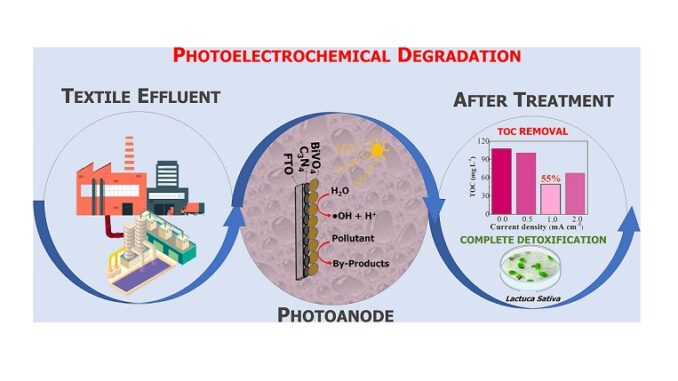

Semiconductors made of carbon nitride and bismuth vanadate were synthesized in the study (image: CDMF)
Investigators affiliated with two FAPESP-supported research centers conducted an experiment using actual effluent from the textile industry. The results are detailed in the journal Chemosphere.
Investigators affiliated with two FAPESP-supported research centers conducted an experiment using actual effluent from the textile industry. The results are detailed in the journal Chemosphere.

Semiconductors made of carbon nitride and bismuth vanadate were synthesized in the study (image: CDMF)
Agência FAPESP* – Photoelectrochemical processes have been considered sustainable alternatives for the remediation of water contaminated by domestic or industrial effluents. Simply put, the strategy consists of using solar energy to degrade organic pollutants.
In an article published in the journal Chemosphere, researchers in Brazil describe the synthesis of several different semiconductor materials that can be used as photoanodes.
Photoanodes are the medium for photogeneration of electrons to produce an electric current in photoelectrochemical systems. The article also describes the use of one of these materials to remove toxic substances such as dyes from real-world effluent produced by the textile industry.
The researchers are affiliated with the Center for Development of Functional Materials (CDMF) and the Center for Innovation in New Energies (CINE).
CDMF is a Research, Innovation and Dissemination Center (RIDC) established by FAPESP at the Federal University of São Carlos (UFSCar). CINE is an Engineering Research Center (ERC) supported by FAPESP and Shell, with facilities at various institutions.
The study was funded by FAPESP via two projects (20/14741-6 and 17/11986-5).
In the study, the researchers synthesized semiconductors comprising carbon nitride (C3N4) and bismuth vanadate (BiVO4).
Bismuth vanadate, associated with the use of solar energy, removed toxic substances efficiently with low electricity consumption. The results suggest that the material, which is inexpensive and easy to produce, has potential applications in industry, especially to treat wastewater from textile mills. Production of the material can be combined with the generation of hydrogen, which in turn can be used to produce electricity.
The article “Efficient photoelectrochemical real textile wastewater detoxification using C3N4–BiVO4 photoanodes” is at: www.sciencedirect.com/science/article/abs/pii/S004565352400208X.
* With information from CDMF.
Republish
The Agency FAPESP licenses news via Creative Commons (CC-BY-NC-ND) so that they can be republished free of charge and in a simple way by other digital or printed vehicles. Agência FAPESP must be credited as the source of the content being republished and the name of the reporter (if any) must be attributed. Using the HMTL button below allows compliance with these rules, detailed in Digital Republishing Policy FAPESP.





